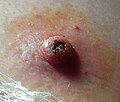Difference between revisions of "Keratoacanthoma"
Jump to navigation
Jump to search
(redirect) |
(+gross) |
||
| Line 11: | Line 11: | ||
*Exophytic lesion, well-circumscribed. | *Exophytic lesion, well-circumscribed. | ||
==Gross== | |||
*Raised dome-like lesions with a central defect. | |||
<gallery> | |||
Image:Keratoacanthoma_2.jpg | Keratoacanthoma. (WC) | |||
</gallery> | |||
==Microscopic== | ==Microscopic== | ||
Features:<ref name=Ref_Klatt378>{{Ref Klatt|378}}</ref> | Features:<ref name=Ref_Klatt378>{{Ref Klatt|378}}</ref> | ||
Revision as of 11:44, 4 July 2013
Keratoacanthoma is clinically worrisome lesion that classically arise on the nose. It is abbreviated KA.
General
- Generally considered to be benign.
- Rare reports of metastases suggesting it may be a form of squamous cell carcinoma.[1]
Clinical
- May grow rapidly (weeks or months) then involute.
- Main DDx is squamous cell carcinoma.
- Exophytic lesion, well-circumscribed.
Gross
- Raised dome-like lesions with a central defect.
Microscopic
Features:[2]
- Expansion of stratum spinosum - pushing tongue-like downward growth of epidermis into the dermis.
- Keratin collection ("keratin plug") at the center of lesion-superficial aspect.
- Cells have glassy pink cytoplasm.
- Minimal/no nuclear atypia.
Note:
- Classically described as a "volcano lesion" with pale pink cells.
- May have features of regression - PMNs, fibrosis (???).
DDx:[3]
- Verruca vulgaris.
- Conventional squamous cell carcinoma of the skin with a cup-shape.
- Pseudoepitheliomatous hyperplasia.
Image
See also
References
- ↑ Mandrell JC, Santa Cruz D (August 2009). "Keratoacanthoma: hyperplasia, benign neoplasm, or a type of squamous cell carcinoma?". Semin Diagn Pathol 26 (3): 150–63. PMID 20043514.
- ↑ Klatt, Edward C. (2006). Robbins and Cotran Atlas of Pathology (1st ed.). Saunders. pp. 378. ISBN 978-1416002741.
- ↑ Busam, Klaus J. (2009). Dermatopathology: A Volume in the Foundations in Diagnostic Pathology Series (1st ed.). Saunders. pp. 379. ISBN 978-0443066542.

